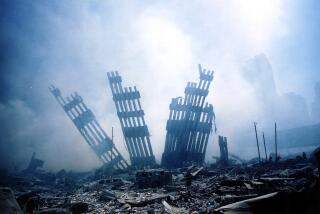Talking terrorism
American counter-terrorism officials are increasingly, and rightly, concerned about Americans joining groups like Al Qaeda. According to a Congressional Research Service report, between Sept. 11, 2001, and May 2009, authorities made arrests in 21 jihadi-related terrorism plots involving people radicalized in the United States. Between May 2009 and November 2010 there were 22 such plots, resulting in two attacks, including the 2009 one at Ft. Hood, Texas. Considering the numbers, it is unsurprising and appropriate that Rep. Peter T. King (R-N.Y.), chairman of the House Homeland Security Committee, plans to hold hearings in early March on Al Qaeda’s recruitment of Americans.
The challenge now is to design a serious hearing that advances Congress’ understanding of the threat, provides a basis for more effective counter-terrorism policy and establishes a narrative to counter Al Qaeda’s propaganda. Unfortunately, early indications suggest that the hearing is instead shaping up to be a politicized circus. Conservative activists and civil libertarians have jumped to long-established fighting positions — respectively, that there is widespread support for jihadis among American Muslims and that hearings on domestic radicalization are necessarily a McCarthy-like witch hunt.
At this point, the most likely outcome of this hearing is that it will be a pointless political show. The worst-case scenario is that the hearing will actually play into the hands of Al Qaeda recruiters.
No one knows exactly why some people become radicalized and others do not. But charismatic leaders such as American-born Islamic cleric Anwar Awlaki — the most effective Al Qaeda recruiter of Americans — are a consistent theme. The uncomfortable reality is that jihadis use the fear and anger generated by a range of controversial current events to promote their virulent ideological concepts. One issue that Awlaki, based in Yemen, exploits is the specter of a government crackdown on Muslim Americans.
In a March 2010 statement titled “A Call to Jihad,” Awlaki argued darkly that “yesterday America was a land of slavery, segregation, lynching and Ku Klux Klan, and tomorrow it will be a land of religious discrimination and concentration camps. Don’t be deceived by the promises of preserving your rights from a government that is right now killing your own brothers and sisters.… The West will eventually turn against its Muslim citizens!”
The March congressional hearing should be carefully designed not to feed into Awlaki’s cynical effort to terrify potential recruits into choosing violence. That means emphasizing the ways that the government can work with Muslim Americans to counter Al Qaeda, rather than labeling wide swaths of that community a threat.
The good news is that Awlaki’s pitch fails far more often than it succeeds. The vast majority of Muslims in the United States and around the world have rejected Al Qaeda’s violent ideology.
That helps explain why Al Qaeda is killing so many Muslims. According to a study by West Point’s Combating Terrorism Center, 85% of Al Qaeda’s victims around the world between 2004 and 2008 were Muslim. Many American policymakers seem to have accepted Al Qaeda’s claim that it acts on behalf of Muslims in general, but the numbers indicate that the group is at war with Muslims as much as it is with the United States.
Such brutality is Al Qaeda’s biggest weakness. U.S. counter-terrorism policy should exploit it by cooperating with Muslim Americans and religious groups abroad to publicize Al Qaeda’s cruelty and discredit jihadis.
One of the criticisms leveled by civil libertarians against the hearing is that it will alienate Muslim Americans by singling them out for investigation rather than exploring the range of domestic terrorism threats, from right-wing militias to radical environmentalists. This is a fair point: domestically radicalized right-wing terrorists have killed more Americans than domestically radicalized jihadis. Nonetheless, the factors that lead to jihadi and right-wing violence seem so different that they demand separate hearings, if only for intellectual clarity.
The radicalization and ideological nexus between jihadi and right-wing terrorism may be tenuous, but the two trends do share important tactical similarities that are worth congressional attention. Both the jihadi 1993 World Trade Center bombing and the right-wing 1996 Oklahoma City bombing utilized explosives based on ammonium nitrate fertilizer. And U.S. law enforcement and intelligence personnel worry about simple attacks using firearms, like the one that paralyzed Mumbai in 2008. There is actually a long lineage of inadvertent information transfer from right-wing militias to jihadis: One of the earliest Internet-based Al Qaeda technical manuals, the Encyclopedia of Preparation for Jihad, included a gigantic amount of data, including jihadi-produced documents, translated U.S. Army Field Manuals and a range of right-wing and militia weapons information.
Nine years after 9/11, the United States should be doing better against Al Qaeda. We should have a clear-eyed understanding of what Al Qaeda is and, critically, what it is not. We should understand that jihadis are a danger in the United States but that they threaten, rather than represent, the Muslim American community. We should have learned how to use Al Qaeda’s tendency for violence to discredit it. We should be able to discuss Al Qaeda without feeding its recruiting pitches. The King hearing would be a good opportunity to make up for lost time.
Brian Fishman is a counterterrorism research fellow at the New America Foundation and an adjunct professor at Georgetown University’s School of Foreign Service.
More to Read
A cure for the common opinion
Get thought-provoking perspectives with our weekly newsletter.
You may occasionally receive promotional content from the Los Angeles Times.










